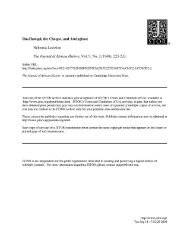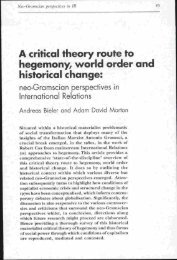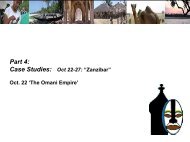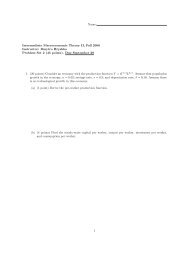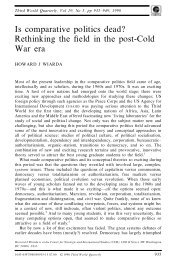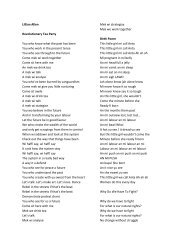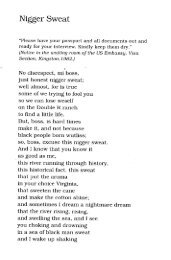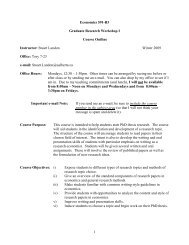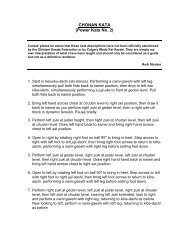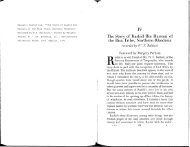personal memories revolutionary states and indian ocean migrations
personal memories revolutionary states and indian ocean migrations
personal memories revolutionary states and indian ocean migrations
You also want an ePaper? Increase the reach of your titles
YUMPU automatically turns print PDFs into web optimized ePapers that Google loves.
Qur’an, Abu Bakr still waited a few days to bury Muhammad’s corpse. In view of the many<br />
inconsistencies concerning the death of Muhammad, it is quite possible that there were Muslim hadith<br />
in al-Kindi’s day which reported that he was to be resurrected in a manner similar to Jesus. Moreover,<br />
it appears that none of the later Muslim apologists even tried to respond to al-Kindi’s charge, though<br />
they must certainly have known of it at least through al-Biruni. Be that as it may, the matter of<br />
Muhammad’s resurrection has long been a subject of dispute in Muslim circles, see Fritz Meier, ‘Eine<br />
auferstehung Mohammeds bei Suyuti,’ Der Islam, vol. 62 (1985): 20-58.<br />
57 Mundhiri, Kitab fi ’l-radd ‘ala ’l-nasara, 128-9.<br />
58 Cf. Irfan Shahid <strong>and</strong> A.F.L. Beeston, “Kinda,” Encyclopaedia of Islam, CD-ROM version, Leiden: E.J.<br />
Brill, 2002.<br />
59 Imru’ al-Qays, considered the most distinguished Arab poet of the pre-Islamic period, was a Kindī.<br />
60 Tien, “Apology of al-Kindi,” 463.<br />
61 Literally, “Mundhir son of the water of the sky.” This is Mundhir III, who reigned from 503-54. Cf.<br />
Irfan Shahid, “Lakhmids,” Encyclopaedia of Islam, CD-ROM version.<br />
62 Mundhiri, 185-192, includes Imru’ al-Qays’s poems on these events,. Cf. S. Boustany, “Imru’ al-<br />
Kays b. Hudjr,” Encyclopaedia of Islam, CD-ROM version. Boustany tells the story in a manner close to<br />
Mundhiri’s version, identifying the emperor as Justinian in Constantinople, <strong>and</strong> saying that the<br />
poisoned shirt was allegedly a punishment for Imru’ al-Qays’ seduction of Justinian’s daughter,<br />
although “in fact history does not mention that Justinian had a daughter.”<br />
63 Mundhiri, 173-188.<br />
64 Tien, “Apology of al-Kindi,” 471.<br />
65 Mundhiri, 202.<br />
66 Arabic version, 163.<br />
67 Mundhiri, 206.<br />
68 Ibid., 207.<br />
69 Ibid., 208-9.<br />
70 Kindi, Arabic version, 162-3.<br />
71 Mundhiri, 219-230. Anne K. Bang points out that his obituary (Supplement to the Zanzibar Gazette, 2<br />
January 1926) <strong>states</strong> that ‘Ali b. Muhammad never left Zanzibar. She comments, “If this is correct, it<br />
was highly unusual for a member of a scholarly family, Ibadi as well as Shafi‘i. Most of them would at<br />
one point of their life perform the hajj, often combined with a period of study in the Hijaz. For the<br />
Ibadi Omanis, a sojourn in Oman was also common.” Sufis <strong>and</strong> Scholars of the Sea: Family Networks in<br />
East Africa, 1860-1925 (London: RoutledgeCurzon, 2003), 154. Mundhiri’s comment here about the<br />
light appearing over the graves of the Imams in Nizwa would lead us to believe that he did travel to<br />
Oman.<br />
72 Nasir b. Abi Nabhan was the greatest Ibadi scholar of his generation in Oman, <strong>and</strong> the son of the<br />
greatest scholar of the previous generation, he lived from 1778 to 1847. Abu Nabhan <strong>and</strong> his son<br />
Nasir were very critical of the ruling dynasty. After his father’s death in 1822, Sayyid Sa‘id launched an<br />
attack on the family estate, but Nasir was able to counterattack through the use of powerful talismans.<br />
This supposedly frightened Sayyid Sa‘id so much that he took Nasir into his inner circle <strong>and</strong> never let<br />
him out of his sight, even taking him into battle, <strong>and</strong> taking him to Zanzibar, where Nasir died with<br />
his head on the Sayyid’s lap. Nur al-Din ‘Abdallah b. Humayyid al-Salimi, Tuhfat al-a'yan bi sirat ahl<br />
'Uman [The Gem of the Eminent in the History of the People of Oman], 2 vols. in one (Sib, Oman:<br />
Maktabat al-Imam Nur al-Din al-Salimi, 2000), 2: 179, 216-229.<br />
73 ‘Abdallāh b. Salih al-Farisi, Al-Bu Sa‘idiyyun, hukkām Zinjibar, anomonously translated from English,<br />
3rd ed. (Muscat: Ministry of National Heritage <strong>and</strong> Culture, 1415/1994), 90.<br />
74 Anne K. Bang <strong>and</strong> Knut S. Vikor, “A Tale of Three shambas: Shafi‘i-Ibadi legal cooperation in the<br />
Zanzibar Protectorate,” Part I, Sudanic Africa: A Journal of Historical Sources 10 (1999): 1-26.<br />
75 Nur al-Din ‘Abdallah b. Humayyid al-Salimi, Badhl al-majhud fi mukhalafat al-nasara wa ’l-yahud (Sib:<br />
Maktabat al-Imam Nur al-Din al-Salimi/ Matabi‘ al-Batina, 1995).<br />
76 Yusuf b. Isma‘il al-Nabhani, Hadha kitab irshad al-hayara fi tahdhir al-muslimin min madaris al-nasara<br />
(Beirut: n.p., 1901).<br />
77 Muhammad Tal‘at Harb, Tarbiyat al-mar’a wa ’l-hijab [Women’s Education <strong>and</strong> the Veil] (Cairo: n.p.,<br />
1899). This book was written in response to Qasim al-Amin’s famous Tahrir al-mar’a [The<br />
Emancipation of Women] (Cairo: Maktabat al-Tarqi, 1899). Both books have been republished<br />
numerous times. Ironically, Harb’s book was reissued in 1905 by Matba‘at al-Manar, the publishing<br />
company established by Muhammad ‘Abduh’s disciple, Muhammad Rashid Rida. It is ironic because<br />
some believe Amin’s book actually to have been the work of ‘Abduh, <strong>and</strong> was certainly written under<br />
‘Abduh’s influence. Rida, however, became more conservative than his master, <strong>and</strong> admired the<br />
Wahhabi movement of Arabia. Significantly, a recent edition of Harb’s book was published in Riyad,<br />
http://web.mit.edu/cis/www/mitejmes/<br />
77



